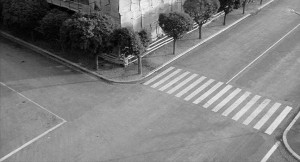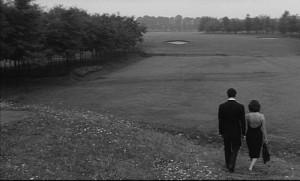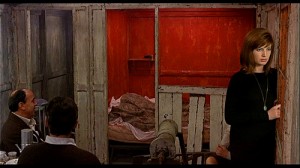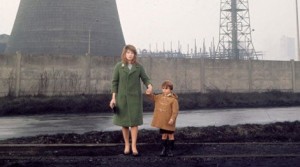This essay was commissioned in fall 2018 for an exhibition devoted to Michelangelo Antonioni in Tehran curated by Sami Astan. — J.R.

[Antonioni’s] trilogy was concerned with differing aspects of love as the medium of hope in our world. This film [Red Desert] is stripped to naked essence — hope or nonhope unadorned: the prospect of human life in the midst of whirling changes. We live, as we know, in the age of the swiftest transition in history, and all indications are that the speed of change will increase: in everything from household appliances to concepts in philosophy, the whole architecture of thought. Antonioni seems to be saying, without effervescent cheeriness, that what was valuable can be preserved or can be transmuted to a new viability: that the future may contain new, at present inconceivable, values. — Stanley Kauffmann, The New Republic, March 23, 1963
There seems little doubt that Red Desert (1964) represented a major turning point in both the art and the career of Michelangelo Antonioni, and not only because it was his first film in color. It also concluded his collaborations with Monica Vitti as his lead actress — in L’avventura (1960), La notte (1961), and L’eclisse (1962) — apart from the sole and significant exception of The Mystery of Oberwald (1980) sixteen years later, which also worked with image (including color) manipulations. And, perhaps most decisively of all, it marked a turning away from the post-neorealism visual style of all his previous black-and-white films and a move towards a form of expressionism that was prompted directly by the introduction of color to his cinema. And what could already be read as an overall movement from narrative (often in the form of mystery stories) towards stasis and abstraction in his earlier works becomes further implemented here by literal (that is, cinematographic) changes of focus. It is hardly accidental that the opening industrial shots of Il deserto rosso, seen behind the credits, are all out of focus, privileging abstraction — in this case, by suggesting Impressionist painting — from the outset. And the clearly focused bursts of flames coming from an industrial plant that immediately follows already postulates a kind of dialectic between aestheticism and brute reality.
The aestheticism is emphasized throughout most of the film by focus changes, carefully composed framings, uses of telephoto and zoom lenses, electronic music (along with industrial noises) on the soundtrack, and expressionistic uses of color intensified by painting or repainting certain locations, filters, and elaborate forms of color coding (most obvious in the uses of red to represent sexual desire — especially in the not-quite-orgy that takes place in a shack where several couples gather, but also in the pink aura of a bedroom much later to evoke Giuliana’s postcoital state). And the brute reality is mostly a matter of the polluted and often foggy industrial landscapes, as well as the often furtive and hesitant human interactions that we see occurring within them.
For film historian Peter Bondanella, Antonioni’s black and white films, from his early shorts in the 40s and 50s to his eight features from 1950 to 1962, weren’t so much post-neorealism as a decisive “break with neorealism”, as suggested by the title of his fourth chapter in Italian Cinema: From Neorealism to the Present (New York: Fredrick Ungar Publishing Co, 1983). Perhaps such a distinction is mainly a matter of semantics, but it seems to me a distinction worth making, because from a broader view of Italian cinema as a whole, Antonioni shared with his neorealist predecessors a strong impulse towards bearing witness towards the spirit and conditions of his own era, even if he intellectualized this interest by often making it a matter of zeitgeist as much as physical and social realities. He also settled in all but one of his features on wealthy or upper-middle-class characters rather than on the working-class, the privileged terrain of the neorealists. (Il Grido in 1957 was the only exception.
In what Antonioni partially conceived as a movement from journalism to poetry, and from traditional narrative to a more modernist form of filmmaking, he was already seeking in his second short film — N.U. (Department of Sanitation, 1948), chiefly about spazzini (garbage collectors), which might be regarded as a quintessential neorealist subject — to create “a montage that would be absolutely free, poetically free”, thus rendering something closer to a mood than an objective reality or a “logical” exposition of facts or appearances. But even though the beginning and end of this twelve-minute film adheres somewhat to this approach—already anticipating the powerful concluding sequence of L’eclisse (which I regard as the climax and high point of all his black and white films)–by focusing on exterior locations and conjuring up a kind of urban poetry out of the succession of shots and their juxtapositions—this is soon accompanied by a brief male voiceover that squarely locates the film’s focus on street cleaners and the fact that most people don’t pay much attention to them or think about them, which clearly plants the film within a neorealist agenda. Yet even though the remainder of the film follows an equally conventional neorealist format of being structured around a single day, from dawn to dusk, various details veer away from the street cleaners to show other, mostly (but not entirely) various related subjects. We see, for instance, streets being littered by a few people, sometimes just before a streetcleaner arrives to clean up the mess. Some of these incidents seem to be pre-arranged and staged for his camera, as in a fiction film (especially when more well-to-do individuals are involved), but presumably not the apparently homeless man who shakes out his blanket on the sidewalk before curling up at the foot of a building that is revealed by an upward pan to be a church. We also later see evidence of how the garbage being collected is picked through by scavengers (or gleaners, as Agnès Varda would call them) or else fed to pigs, while some other shots seem to qualify more as atmospheric than as illustrations of the early voiceover commentary or as explorations of class differences. One memorable shot shows a streetcleaner walking with his girlfriend or wife while dragging his broom lackadaisically behind him.
In short, Antonioni often uses a neorealist format as a launching pad more than as a goal or destination — a practice that one can see replicated in the closing minutes of L’eclisse, where a documentary-like exploration of a particular subject — in this case a particular location over a single dusk and evening, also viewed without any sustained characters — takes on poetic and thought-provoking qualities, although in the latter case with disturbing, frightening, and even somewhat apocalyptic overtones. Coming at the conclusion of a 126-minute story centered mostly on the fitful love life of Vitti’s Vittoria, including her flirtation with Alain Delon’s Piero and their plan to meet at this street corner at 8 PM, this is above all a poetry of absence and uncertainty, and not only because both Vittoria and Piero fail to keep their appointment (which may or may not be significant). It’s also a way of saying, more profoundly, that the story stops and the world in all its unfathomable mystery takes over. 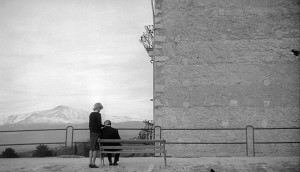
Throughout Antonioni’s celebrated early 60s trilogy, the main focus, as Stanley Kauffmann implies, is on the shifting relations and interactions between couples in the present world — in Sicily and nearby islands in L’avventura, in Milan in La notte, and in Rome (including that desolate street corner) in L’eclisse. Red Desert seems more concerned with thoughts about the future, even though it’s set equally in the present, this time in a polluted sea port. It doesn’t quite qualify as science fiction, but it does suggest a form of what might be called “speculative fiction” (Robert Heinlein’s proposed alternate name for the genre). What links it most to Antonioni’s preceding black and white trilogy is the notion that shots should be regarded as questions, explorations, or interrogations rather than as declarative statements that might function as answers. According to this characteristic, the film’s title becomes still another question: “red desert” can refer to either the film’s brute reality (with “desert” signifying “wasteland” and/or a dry and burning form of absence) or to its aestheticism (which could refer us to either unsatisfied sexual desire, according to the color coding cited above, or to the presexual bliss of the girl in Giuliana’s story to her son, as represented by the pink beach where she luxuriates in her innocence.
This leads one to consider the possibility that Red Desert may represent a key point of transition between the view of eroticism as a form of contemporary sickness in L’avventura and La notte and the unabashed celebration of eroticism that became the dominant subject of much of his last (and, alas, much weaker) work. Regarding the first tendency, let me quote a short, central passage from the notorious and lengthy statement Antonioni released in Cannes at the premiere of L’avventura, which appears to have been as crucial to what made the film controversial as its unresolved mystery and its slow pace:
…Why do you think eroticism is so prevalent today in our literature, our theatrical shows, and elsewhere? It is a symptom of the emotional sickness of our time. But this preoccupation with the erotic would not become obsessive if Eros were healthy, that is, if it were kept within human proportions. But Eros is sick; man is uneasy, something is bothering him. And whenever something bothers him, man reacts, but he reacts badly, only on erotic impulse, and he is unhappy. –from a discussion in Bianco e nero (1961), translated in Film Culture, Spring 1962
The intellectual, social, and philosophical claims being made by Antonioni in this overall statement, which are only barely suggested here, postulate an existential crisis in Western civilization that is spelled out in the major events of both L’avventura and La notte, most of which are perceived as both erotic and futile. L’eclisse begins at the conclusion of a love affair that is viewed in a similarly glum fashion, but the subsequent affair of the heroine, Vittoria (Vitti), with a stock broker, Piero (Delon), however tentative, is seen in a less negative fashion. And the same could be said, if not for the nonconclusive flirtations that we witness in the red shack in Red Desert, at least for Giuliana’s telling her husband afterwards that she wants to make love with him, as well as in the temporary dalliances of the hero in Blowup with two teenage girls and Vanessa Redgrave, and in the more sustained bouts of lovemaking seen or evoked in Zabriskie Point, Identification of a Woman, and Beyond the Clouds, moving increasingly towards pornographic celebrations. Arguably, a diminished or abolished interest in the zeitgeist seems to accompany and perhaps even corresponds to the obsessive “preoccupation with the erotic” decried by Antonioni years or decades earlier. But given the relative ambiguity of most of these sequences, and Antonioni’s intuitive rather than calculated or systematic approach to filmmaking, this thesis must remain both tentative and speculative.
Couples and environments both exist as facts of life in Red Desert — a married couple with a child and factories and industrial wastelands in or around Ravenna — but the emphasis on interactions has become secondary, to be replaced more often by the states of mind and the feelings of a single character: Monica Vitti’s Giuliana, as represented by her surroundings. Yet Giuliana — the wife and mother, who eventually takes on a lover (Richard Harris’s Corrado) after her husband (Carlo Chionetti) leaves on a business trip — is arguably no more developed as a character than Vittoria was in L’eclisse, and the fact that we rarely approach the consciousness of the men (apart from the scene in which Corrado distractedly speaks to workers about Patagonia, the only occasion in the film when Giuliana isn’t present) suggests that social or aesthetic placement may ultimately matter more to Antonioni than psychological adjustment in any normal sense. Complicating this distinction is the fact that, in spite of the intellectual cast of many of Antonioni’s public statements and his responses in many interviews (such as his dialogue with Godard), his creative decisions as a filmmaker often appear to be more intuitive than intellectually calculated.
One could therefore argue that, as with the neorealist trappings of N.U. and the romantic trappings of L’eclisse, Antonioni is using Giuliana’s neurotic consciousness as a springboard into exploring a poetry of places — more specifically, a poetry anchored in the problem of adjusting to the alienating aspects of industrial landscapes. Within such a world, Giuliana’s frequent attraction towards the arrival of ships seems connected to dreams of escape — the sort of escape readily available to Corrado, who is currently recruiting industrial workers for employment in Patagonia, but not to her.

What makes the film expressionistic is Antonioni’s having repainted many of the environments she passes through or inhabits in order to render her mental and emotional states — in some ways to counter them (as in counterpoint), when he finds these forbidding landscapes beautiful, and wants therefore to enhance them, and in some ways merely to accent or inflect them, by dramatizing Giuliana’s alienation from them. Our lack of certainty about what we can regard as objective or as subjective within this doctored and composed universe remains the film’s perpetual zone of mystery and uncertainty — indeed, the principal focus of both Antonioni’s explorations and our own questions. Far more vulnerable than any of the characters in L’avventura and La notte (with the notable exception of a mental patient and nymphomaniac in the latter film), Giuliana, as we gradually discover, is recovering from a suicide attempt that is usually described euphemistically to others as a nervous breakdown. Her instability is already made apparent in the opening sequence, when she insists on buying a half-eaten sandwich from a stranger outside an industrial plant.
When Giuliana’s young son temporarily becomes paralyzed from the waist down — a malady that we’re led to conclude has some relation to him having absorbed or intuited aspects of his mother’s mental state — tells him a story of her own poetic invention that the film illustrates, in a sequence featuring a young girl and filmed on an island off the coast of Sardinia. Significantly, this is the only part of the film that shows us nature in an untroubled state and where the colors that we see are natural (that is, non-expressionistic and doctored by neither painting nor filters), even though paradoxically the story being told is utter fantasy. One can conclude from this that most of this film springs from Giuliana’s consciousness—which is largely a vision of hell, but also contains this vision of heaven. (Whether this latter vision belongs to Giuliana’s past or her future—or possibly to both—is one of the film’s other unanswered questions.) The solo female singing voice heard behind the credits and then in the latter part of Giuliana’s fairy tale — where she says that “everyone” and “everything” is singing — implies a kind of mournful duet between her own soulful song and the “music” of Antonioni’s sounds and images, unifying both visions.


